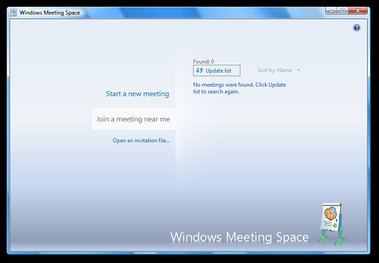Replaces NetMeeting | ||
 | ||
Windows Meeting Space (codenamed Windows Shared View and also referred to as Windows Collaboration) was a peer-to-peer collaboration program developed by Microsoft and included with Windows Vista that supports up to 10 users. It is a replacement for the older Windows NetMeeting application; however, features such as microphone support and the ability to set up audio or video conferences are now removed.
Contents
Meeting Space enables application sharing, collaborative editing, desktop sharing, file sharing, projection, and simple text-based or ink-based instant messaging across users connected to the same local network or the Internet. Meeting Space has the ability to automatically set up an ad hoc wireless network if a local network or connection to the Internet are not available and also enables participants to invite other people to meeting sessions. It is notable in that it is one of the first applications for the Windows Vista peer-to-peer framework and hence requires IPv6.
Meeting Space is available in all editions of Windows Vista, but its functionality is unavailable in the Starter edition; in the Home Basic edition, it only allows users to join sessions. Meeting Space does not exist in any version of Windows 7, for which Microsoft has recommended Microsoft Office Live Meeting as a replacement.
History
Meeting Space is a result of Microsoft's peer-to-peer collaboration efforts—with an emphasis on mobile computing—discussed during the Windows Hardware Engineering Conference of 2004 when Windows Vista was codenamed "Longhorn." At that time, it was reported that Windows Vista would enable users to create "ad hoc wireless networks for file sharing and to discover people who are connected nearby." Meeting Space relies on this functionality for its services.
Meeting Space was first demonstrated by Jim Allchin and Darryn Dieken at the Professional Developers Conference (PDC) in 2005 where it was used to project a PowerPoint presentation. Allchin stated that this demonstration was not intended to illustrate the capabilities of the application itself—which was not complete at the time—but to illustrate the capabilities of the peer-to-peer framework in Windows Vista, which uses IPv6, file replication, and ad hoc capabilities. In a later interview with Paul Thurrott, Allchin later expressed his desire for developers to create applications with support for these peer-to-peer capabilities.
Overview and features
On starting a session, a workspace, which contains a presentation area, is displayed. A list of notes are also shown. A list of users in the local subnet, with whom a collaboration session can be started, are automatically detected by using the People Near Me functionality, based on WS-Discovery in the peer-to-peer networking implementation in Windows Vista. Users outside the local subnet must be sent an e-mail or file invitation to participate. Applications can be shared in the session, which will be local to that session only. When an application is shared, Windows Meeting Space switches into presentation mode so that participants can see what the presenter is working on and collaboratively edit or review the shared application instance.
